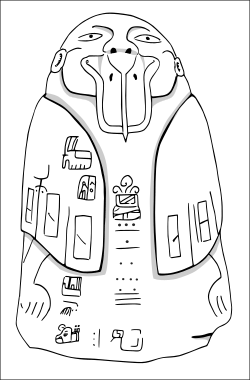Tuxtla Statuette facts for kids
Quick facts for kids Tuxtla Statuette |
|
|---|---|

Frontal view of the Tuxtla Statuette. Note the Mesoamerican Long Count calendar date of March 162 CE (8.6.2.4.17) down the front of the statuette.
|
|
| Material | Greenstone |
| Discovered | 1902 in the west foothills of the Tuxtlas Mountains, Veracruz, Mexico |
| Present location | Department of Anthropology, National Museum of Natural History, Smithsonian Institution, Washington, D.C. |
The Tuxtla Statuette is a small, special stone figure. It is about 6.3 inches (16 cm) tall. This ancient carving looks like a person with a duck-like beak and wings. Many experts think it shows a shaman, a spiritual leader, dressed as a bird.
The statuette has 75 carved symbols, called glyphs. These symbols are part of an old writing system called Epi-Olmec or Isthmian script. This makes the Tuxtla Statuette very important for understanding ancient writing in Mesoamerica.
Contents
What is the Tuxtla Statuette?
The Tuxtla Statuette is made from a type of rock called greenstone. It shows a human face with a long beak that goes down its chest. This beak looks like the one from a boat-billed heron. These birds are common in the area where the statuette was found.
The figure also has raised wings or a cape that looks like wings. Its feet are carved into the bottom of the statue. It's a very unique and detailed piece of ancient art.
Why is the Tuxtla Statuette Important?
This statuette is very special because of the symbols carved on it. These symbols include a date from the Mesoamerican Long Count calendar. This date is March 162 CE. When the statuette was found in 1902, this was the oldest Long Count date ever discovered!
The statuette comes from the Epi-Olmec culture. This culture lived in the same area and at the same time as the people who made La Mojarra Stela 1. Some experts think the statuette might even talk about the same events or people as the stela.
There are also similarities between the Tuxtla Statuette and another ancient carving. This is Cerro de las Mesas Monument 5. That monument shows a figure with a duckbill-like mask, just like the statuette.
How Was the Tuxtla Statuette Found?
A farmer found the Tuxtla Statuette in 1902. He was plowing his field in the western hills of the Tuxtlas Mountains. This area is in the state of Veracruz, Mexico.
Soon after it was found, the Smithsonian Institution bought it. People say it was secretly brought into New York. It was hidden in a shipment of tobacco leaves.
At first, some experts thought the statuette was not as old as its date said. They believed the date and writing were added much later. But other discoveries, like La Mojarra Stela 1 and Tres Zapotes Stela C, proved that the statuette was indeed very ancient.
Where Can You See the Tuxtla Statuette?
Today, the Tuxtla Statuette is kept in the Department of Anthropology. This is part of the National Museum of Natural History in Washington, D.C. You can see it on display in the museum's "Objects of Wonder" exhibit.
Images for kids
See also
 In Spanish: Estatuilla de Tuxtla para niños
In Spanish: Estatuilla de Tuxtla para niños



